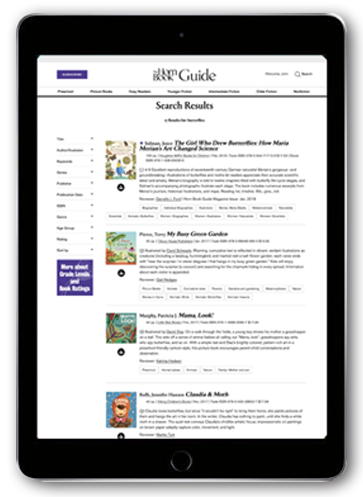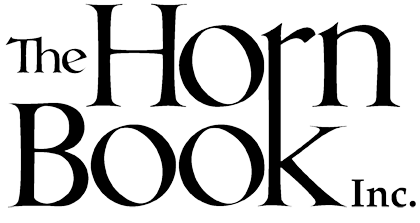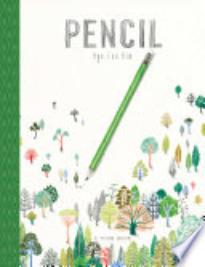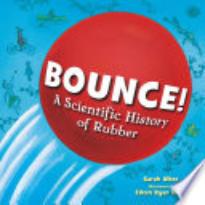Manufacturing
80 Reviews
(2)
K-3
This wordless picture book creatively and thoughtfully explores the life cycle of a pencil from tree to drawing implement. The story starts on a blank page with a pencil being sharpened. As the pages turn, the shavings morph into leaves, which sprout into an elaborate forest appropriately rendered with colored pencils and markers in bright colors and intricate lines. Readers looking closely will be able to find a range of birds and other forest animals hidden among the trees. Dramatic page layouts on stark white backgrounds heighten the tension when the trees are cut down, expelling the birds from their homes. Color also plays an important role in the story's unfolding as the vivid colors of the logs from the forest overtake the leaden shades of black, white, and gray of the city and factory, where the wood will become colored pencils. The art returns to full color when a child purchases one of the pencils in an art supply store and uses it to draw the forest back to life. The story poses meaningful questions about the origins of everyday objects and the sacrifices they require to produce, but the creative visual exploration leaves room for delight and inspiration as well. The book closes with well-considered prompts for deepening the experience of reading a wordless book.
Reviewer: Julie Roach
| Horn Book Magazine Issue:
July, 2025
(2)
K-3
Illustrated by
Eileen Ryan Ewen.
Inviting readers into this spirited book, a bouncing red-rubber ball generates a path leading from the initial endpapers to the first words of text. Here readers discover properties of rubber: that it can bounce, stretch, roll, and be molded. Animated illustrations at times combine with text treatment to graphically reinforce features of rubber (e.g., under vignettes of children riding a rubber-tired tricycle, scooter, and bike: "It can r o o o o o o ll"). By posing three questions, Albee provides an outline of what readers can expect to learn about rubber: "Who discovered it? Where does it come from? How is it made?" As promised in the subtitle, she provides scientific explanations for each of the properties discussed in the introduction. Spot art supports clear, understandable explanations of scientific steps, as well as key historical moments of discovery. Throughout, Ewen's bright watercolor illustrations both pace and inform this lively text, creating a book as bouncy as the original red ball. Extensive back matter includes a note about the nomenclature of Indigenous people of South America who first discovered rubber, a discussion of environmental problems and historical conflicts involving rubber today, a timeline, a bibliography, and documentation.
Reviewer: Betty Carter
| Horn Book Magazine Issue:
January, 2025
(1)
4-6
This is a neatly constructed story of two parallel characters. Gladys is a small, bright, intense eleven-year-old with a sensitive nature and quirky clothing sense. Her mom runs an in-home daycare. Jude, also eleven, is big for his age, the son of a single mother and the frequent caregiver for his little brother. Their stories are told in alternating chapters (in different typefaces) and come together when each encounters True, a neglected dog in the neighborhood. True's rescue forms the core of the action. Springstubb (The Most Perfect Thing in the Universe, rev. 9/21) does a masterly job of creating two distinct voices and sustaining our interest in the two main characters equally. A supporting cast of flawed adults and hilarious preschoolers rounds out the picture. The setting--a town formerly prosperous but now on the skids, where folks are just scraping by, with subtle reference to the opioid crisis and the collapse of the manufacturing economy--is one that is underrepresented in contemporary middle-grade fiction, and it mitigates against the potential soppiness of a dog-rescue story. The writing is fresh, sharp, and authentic: "This could be trouble, said his brain. Open the door, said whatever the opposite of a brain was." It's Because of Winn-Dixie (rev. 7/00) for a new generation.
Reviewer: Sarah Ellis
| Horn Book Magazine Issue:
November, 2022
Deutsch, Libby
The Everyday Journeys of Ordinary Things: From Phones to Food and from Paper to Poop... The Ways the World Works
(3)
4-6
Illustrated by
Valpuri Kerttula.
Where did your breakfast banana come from? How are your jeans made? How does your house have electricity? Each two-page spread illuminates these and other "journeys" with numbered steps for each process. Technologies such as cellphones, the internet, and--yes--indoor plumbing are covered. A fascinating behind-the-scenes look at items and systems readers may take for granted. Back matter would have increased the educational value.
Reviewer: Janet Dawson
(3)
K-3
How Is It Made? series.
Close-up color photos illustrate each step in the creation of the titular items, from raw material (sugar, nectar, sap) to final product. Two or three simple sentences add very basic but level-appropriate explanation to each spread's picture; curious young readers may seek out more substantive information. A few additional facts are appended. Glos., ind. Review covers these How Is It Made? titles: How Is Cotton Candy Made?, How Is Honey Made?, How Is Maple Syrup Made?, and How Is Root Beer Made?.
Reviewer: Gail Hedges
(3)
K-3
How Is It Made? series.
Close-up color photos illustrate each step in the creation of the titular items, from raw material (sugar, nectar, sap) to final product. Two or three simple sentences add very basic but level-appropriate explanation to each spread's picture; curious young readers may seek out more substantive information. A few additional facts are appended. Glos., ind. Review covers these How Is It Made? titles: How Is Cotton Candy Made?, How Is Honey Made?, How Is Maple Syrup Made?, and How Is Root Beer Made?.
Reviewer: Gail Hedges
(3)
K-3
How Is It Made? series.
Close-up color photos illustrate each step in the creation of the titular items, from raw material (sugar, nectar, sap) to final product. Two or three simple sentences add very basic but level-appropriate explanation to each spread's picture; curious young readers may seek out more substantive information. A few additional facts are appended. Glos., ind. Review covers these How Is It Made? titles: How Is Cotton Candy Made?, How Is Honey Made?, How Is Maple Syrup Made?, and How Is Root Beer Made?.
Reviewer: Gail Hedges
(3)
K-3
How Is It Made? series.
Close-up color photos illustrate each step in the creation of the titular items, from raw material (sugar, nectar, sap) to final product. Two or three simple sentences add very basic but level-appropriate explanation to each spread's picture; curious young readers may seek out more substantive information. A few additional facts are appended. Glos., ind. Review covers these How Is It Made? titles: How Is Cotton Candy Made?, How Is Honey Made?, How Is Maple Syrup Made?, and How Is Root Beer Made?.
Reviewer: Gail Hedges
(3)
K-3
How Is It Made? series.
Close-up color photos illustrate each step in the creation of the titular items, from raw material to final product. Two or three simple sentences add very basic but level-appropriate explanation to each spread's picture; curious young readers may seek out more substantive information. A few additional facts are appended. Glos., ind. Review covers these How Is It Made? titles: How Is a Firework Made? and How Is a Pencil Made?.
Reviewer: Gail Hedges
(3)
K-3
How Is It Made? series.
Close-up color photos illustrate each step in the creation of the titular items, from raw material to final product. Two or three simple sentences add very basic but level-appropriate explanation to each spread's picture; curious young readers may seek out more substantive information. A few additional facts are appended. Glos., ind. Review covers these How Is It Made? titles: How Is a Firework Made? and How Is a Pencil Made?.
Reviewer: Gail Hedges
(3)
4-6
Engineering That Made America series.
This series takes an in-depth look at the history, conception, and practical application of key engineering feats and inventions. Each volume thoughtfully breaks down events and inspiration that led up to each invention, as well as its evolution and impact over the years. Archival photos break up the narratives. There are four other spring 2017 books in this series. Reading list, timeline. Glos., ind. Review covers these Engineering That Made America titles: The Invention of the Assembly Line, The Invention of the Airplane, The Invention of the Transistor, and The Building of the Hoover Dam.
Reviewer: Kristy Pasquariello
(2)
YA
A mysterious glow-in-the-dark painting links modern-day teen Julie to Lydia and her sisters, in 1917–18, as they work at a factory that produces luminous watch faces, unaware that the paint they use causes radiation poisoning. This parallel narrative gives Julie's conventional YA romance story an infusion of originality. The historical background (expanded in an author's note) is intriguing, embracing chemistry, medicine, and labor and women's histories.
Reviewer: Sarah Ellis
| Horn Book Magazine Issue:
November, 2017
(3)
K-3
How Is It Made? series.
Close-up color photos spill across the gutter to illustrate each step in the creation of the titular items, from raw agricultural material (cotton and wool, cacao beans, milk, peanuts) to final product. Two or three simple sentences add very basic but level-appropriate explanation to each spread's picture; curious young readers may seek out more substantive information. A few additional facts are appended. Glos., ind. Review covers these How Is It Made? titles: How Is a Sweater Made?, How Is Chocolate Made?, How Is Ice Cream Made?, and How Is Peanut Butter Made?.
Reviewer: Gail Hedges
(3)
K-3
How Is It Made? series.
Close-up color photos spill across the gutter to illustrate each step in the creation of the titular items, from raw agricultural material (cotton and wool, cacao beans, milk, peanuts) to final product. Two or three simple sentences add very basic but level-appropriate explanation to each spread's picture; curious young readers may seek out more substantive information. A few additional facts are appended. Glos., ind. Review covers these How Is It Made? titles: How Is a Sweater Made?, How Is Chocolate Made?, How Is Ice Cream Made?, and How Is Peanut Butter Made?.
Reviewer: Gail Hedges
(3)
K-3
How Is It Made? series.
Close-up color photos spill across the gutter to illustrate each step in the creation of the titular items, from raw agricultural material (cotton and wool, cacao beans, milk, peanuts) to final product. Two or three simple sentences add very basic but level-appropriate explanation to each spread's picture; curious young readers may seek out more substantive information. A few additional facts are appended. Glos., ind. Review covers these How Is It Made? titles: How Is a Sweater Made?, How Is Chocolate Made?, How Is Ice Cream Made?, and How Is Peanut Butter Made?.
Reviewer: Gail Hedges
(3)
K-3
How Is It Made? series.
Close-up color photos spill across the gutter to illustrate each step in the creation of the titular items, from raw agricultural material (cotton and wool, cacao beans, milk, peanuts) to final product. Two or three simple sentences add very basic but level-appropriate explanation to each spread's picture; curious young readers may seek out more substantive information. A few additional facts are appended. Glos., ind. Review covers these How Is It Made? titles: How Is a Sweater Made?, How Is Chocolate Made?, How Is Ice Cream Made?, and How Is Peanut Butter Made?.
Reviewer: Gail Hedges
(3)
K-3
How Is It Made? series.
Children will be drawn into the origins of these familiar objects. Close-up color photos spill across the gutter to illustrate each step in the manufacturing process, from raw material to final product. Two or three simple sentences add a very basic but level-appropriate explanation to each spread's picture; curious young readers may seek out more substantive information. A few additional facts are appended. Glos., ind. Review covers these How Is It Made? titles: How Is a Book Made? and How Is a Crayon Made?.
Reviewer: Gail Hedges
(3)
K-3
How Is It Made? series.
Children will be drawn into the origins of these familiar objects. Close-up color photos spill across the gutter to illustrate each step in the manufacturing process, from raw material to final product. Two or three simple sentences add a very basic but level-appropriate explanation to each spread's picture; curious young readers may seek out more substantive information. A few additional facts are appended. Glos., ind. Review covers these How Is It Made? titles: How Is a Book Made? and How Is a Crayon Made?.
Reviewer: Gail Hedges
(3)
K-3
Robotics in Our World series.
With clear text, strong organization, and appropriate photographs, this high-interest series introduces branches of robotics to newly independent readers. Each book straightforwardly explains the history and current uses of particular types of robots and keeps a rosy outlook on these technological advancements. Bright page colors add to the books' visual appeal without being distracting. Reading list, websites. Glos., ind. Review covers these Robotics in Our World titles: Factory Robots and Drones.
Reviewer: Dorrie Karlin
(3)
4-6
Orca Footprints series.
Information about the history of international trade leads into why fair trade is an important component of today's fight for social justice and equality. Jones urges young people to get involved in spreading the word and changing their own consumer habits. Illustrated with compelling color photographs, the narrative includes anecdotes from the author's international travels in service to fair trade. Reading list, websites. Glos., ind.
Reviewer: Melinda Greenblatt
80 reviews
We are currently offering this content for free. Sign up now to activate your personal profile, where you can save articles for future viewing.
























